Fundamental Nuclear Chemistry
Left: The CMS Experiment
Right: CMS Endcap aboveground
Cessy, France, December, 2007 (MBT)
The CMS (Compact Muon Solenoid) Experiment at the Large Hadron Collider (LHC at CERN) at CERN is a high-energy physics experiment in Cessy, France. The detector is designed to measure different types of particles emerging from high energy collisions of protons. In Heavy Ion running in 2010 and 2011, the LHC collides lead ions at 2.76 TeV center of mass energy, producing dense matter at energies not before created in a laboratory. These collisions are used to study a new state of matter in which quarks and gluons are no longer confined, the QGP (quark-gluon plasma). This leads to a better understanding of the measurements of the QGP at RHIC, as well as the fundamental constituents of matter.

The focus of the group’s involvement in nuclear chemistry is to understand the behavior of nuclear matter at extreme density (pressure) and temperature (energy). This study involves experiments at large colliders that collide protons or ions (Au, Cu, Pb) at relativistic energies.
The Mignerey group has been a member of the PHOBOS experiment at RHIC since the planning stages in 1992. In June 2005, the PHOBOS experiment finished taking data and moved to analysis. In 2006, the group joined the PHENIX experiment at RHIC. In collaboration with UMD High Energy Physics, the Mignerey group works on the CMS experiment at the LHC.

For more information:
Basics of particle physics: http://www.particleadventure.org/
Nuclear Chemistry: http://en.wikipedia.org/wiki/Nuclear_chemistry
Quark Gluon Plasma (QGP) (defined at RHIC)
About Heavy Ion Collisions (CMS outreach)
Jaime and Marguerite participated in the planning and construction of the CMS Lego® model
The CMS Zero Degree Calorimeters in Google Street View: ZDC+ and ZDC-
Collaboration lists:

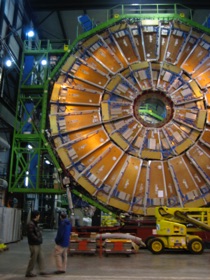


Quenched dijet event as measured in the CMS Calorimeter, PbPb 2.76 TeV, Nov. 2010. PRC 84 (2011)
Views of the PHENIX detector
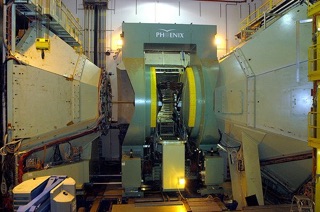
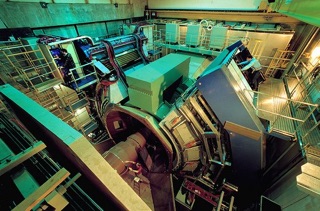
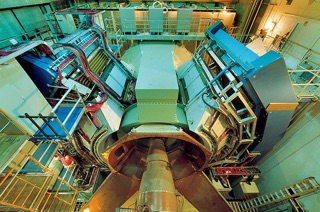
The PHENIX Detector, located at Brookhaven National Laboratory on Long Island, NY, is a large high-tech detector dedicated to characterizing the heavy ion collisions provided by the Relativistic Heavy Ion Collider (RHIC). These collisions recreate a form of matter known as a Quark Gluon Plasma (QGP), which is theorized to have existed just after the big bang. PHENIX characterizes this matter by utilizing its many versatile sub-detectors. Each sub-detector has its own specialty, but when used together a more complete picture of the violent collisions emerge.
The PHENIX experiment has an eclectic mix of participants including undergraduate and graduate students, post-docs, professors, staff scientists and technicians. In total there are around 500 collaborators in the group from 14 countries and 69 institutions.
Select PHENIX publications/talks:
-
•E. Richardson (For PHENIX Collaboration). “Latest Flow Results from PHENIX at RHIC”, proceedings for PANIC11, Massachusetts Institute of Technology, Cambridge, MA, AIP Conference Proceedings, Vol. 1441, 771 (2012)
-
•E. Richardson et al., A reaction plane detector for PHENIX at RHIC, Nucl. Inst. and Meth. A 636 (2011) pp. 99-107
-
•A. Adare et al., [PHENIX Collaboration], Observation of direct-photon collective flow in Au+Au collisions at sqrt(sNN) = 200 GeV, Phys. Rev. Lett. 109, 122302 (2012)
-
•A. Adare et al., [PHENIX Collaboration], Measurements of higher-order flow harmonics in Au+Au collisions at sqrt(sNN) = 200 GeV, Phys. Rev. Lett 107, 252301 (2011)
-
•A. Adare et al., [PHENIX Collaboration], Suppression of away-side jet fragments with respect to the reaction plane in Au+Au collisions at sqrt(s_NN) = 200 GeV, Phys. Rev. C 84, 024904
-
•E. Richardson, “The Latest PHENIX Results on Forward and Central Flow”, RHIC & AGS Users Meeting, Brookhaven National Laboratory, June 7-11 2010.
-
•A. Adare et al., [PHENIX Collaboration], Transition in Yield and Azimuthal Shape Modification in Dihadron Correlations in Relativistic Heavy Ion Collisions, Phys. Rev. Lett. 104, 252301 (2010).
-
• A. Adare et al., [PHENIX Collaboration], Transverse momentum dependence of eta meson suppression in Au + Au collisions at sqrt(sNN) =200 GeV, Phys. Rev. C 82, 011902(R) (2010).
-
• A. Adare et al., [PHENIX Collaboration], Elliptic and Hexadecapole Flow of Charged Hadrons in Au + Au Collisions at sqrt(sNN) = 200 GeV, Phys. Rev. Lett. 105, 062301 (2010).
-
•A. Adare et al., [PHENIX Collaboration], Azimuthal Anisotropy of pi0 Production in Au + Au Collisions at sqrt(sNN) = 200 GeV: Path Length Dependence of Jet Quenching and the Role of Initial Geometry, Phys. Rev. Lett., 105, 142301 (2010).
-
•Eric Richardson, “Elliptic Flow of Unidentified Charged Hadrons at Forward Rapidities in PHENIX”, Joint Meeting of the Nuclear Physics Divisions of the APS/JPS, Waikoloa, Hawaii, October 13-17, 2009.
-
•S. Afanasiev et al., [PHENIX Collaboration], Systematic studies of elliptic flow measurements in Au + Au collisions at sqrt(sNN) =200 GeV, Phys. Rev. C 80, 024909 (2009).
-
•Eric Richardson (for the PHENIX collaboration),“Examination of J/psi Elliptic Flow with the PHENIX Detector in 200 GeV Au+Au Collisions at RHIC”, 236th ACS National Meeting, Philadelphia, Pennsylvania, August 17-21, 2008.

Funded by the U.S. Department of Energy Office of Science

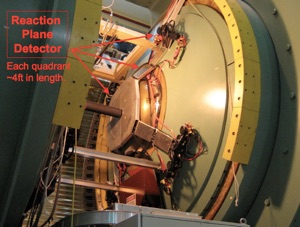
The Mignerey group has significantly contributed to the PHENIX Collaboration by taking part in the testing, assembly, installation and continued maintenance of one of PHENIX's newest detectors, the Reaction Plane Detector (RXNP). The RXNP's specialty was in measuring, with respect to one another, the spacial position of the two heavy ions when they collide. This orientation is characterized by what is known as the reaction plane angle. An accurate reaction plane angle measurement is very important in heavy ion collisions since it provides the starting point for many different types of analysis. During operations the RXNP detector has proved its importance to the collaboration by improving the resolution of PHENIX's reaction plane angle measurement by a factor of 2.










Select CMS publications/talks:
-
•The CMS Collaboration, Observation of long-range near-side angular correlations in proton-lead collisions at the LHC, Phys. Lett. B 718 (2013) 795.
-
•Marguerite B. Tonjes, Inclusive jet and charged hadron nuclear modification factors in PbPb collisions at 2.76 TeV with CMS, proceedings for Quark Matter 2012, Washington, DC, Nucl. Phys. A 904-905 (2013), 713c.
-
•Ying Lu, Unfolding methods in studying nuclear modification factor of high transverse momentum jets in PbPb collisions at sqrt(sNN) = 2.76 TeV, poster, Quark Matter 2012, Washington, DC
-
•The CMS Collaboration, Studies of jet quenching using isolated-photon+jet correlations in PbPb and pp collisions at sqrt(sNN) = 2.76 TeV, Phys. Lett. B 718 (2013) 773.
-
•The CMS Collaboration, Jet momentum dependence of jet quenching in PbPb collisions at sqrt(sNN) = 2.76 TeV, Phys. Lett. B 712 (2012) 176
-
•The CMS Collaboration, Measurement of jet fragmentation into charged particles in pp and PbPb collisions at sqrt(sNN) = 2.76 TeV, accepted by JHEP 10 (2012) 087.
-
•The CMS Collaboration, Observation and studies of jet quenching in PbPb collisions at sqrt(sNN) = 2.76 TeV, Phys. Rev. C 84 (2011) 024906
-
•Marguerite B. Tonjes, “Study of jet quenching using dijets in PbPb collisions with CMS”, proceedings for Quark Matter 2011, Annecy, France, J. Phys. G: Nucl. Part. Phys. 38 124084 (2011)
-
•Marguerite B. Tonjes, invited talk: “LHC and Future Directions in Heavy Ion Physics”, 2010 Fall meeting of the APS Division of Nuclear Physics, Nov. 2-6, 2010, Santa Fe, NM
-
•Marguerite B. Tonjes, “Jet Analysis in Heavy Ion Collisions with CMS”, ICHEP08, 29 July - 5 Aug 2008, Philadelphia, PA
-
•Alice Mignerey, “Soft Physics in Pb+Pb Collisions at 5.5 TeV Using the CMS Detector”, ICHEP08, 29 July - 5 Aug 2008, Philadelphia, PA
-
•The CMS Collaboration, High Density QCD with Heavy-Ions, J.Phys. G: Nucl. Part. Phys. 34 (2007) 2307-2455.
-
•The CMS Collaboration, Indications of Suppression of Excited Upsilon States in Pb-Pb Collisions at sqrt(sNN) = 2.76 TeV, Phys. Rev. Lett. 107 (2011) 052302
-
•The CMS Collaboration, Long-range and short-range dihadron angular correlations in central PbPb collisions at sqrt(sNN) = 2.76 TeV, J. High Energy Phys. 07 (2011) 076
-
•The CMS Collaboration, Observation of Long-Range, Near-Side Angular Correlations in Proton-Proton Collisions at the LHC, J. High Energy Phys. 09 (2010) 091
The Mignerey group is involved in upgrades for sPHENIX. In particular, students are participating at Brookhaven National Laboratory on tests of the MPC-EX Detector (Muon-Piston Calorimeter Extension).

MPC-EX Design: http://arxiv.org/abs/1301.1096
page last edited:
February 4, 2017, by MBT



Copyright © 2008-2017. The Department of Chemistry and Biochemistry. All rights reserved




